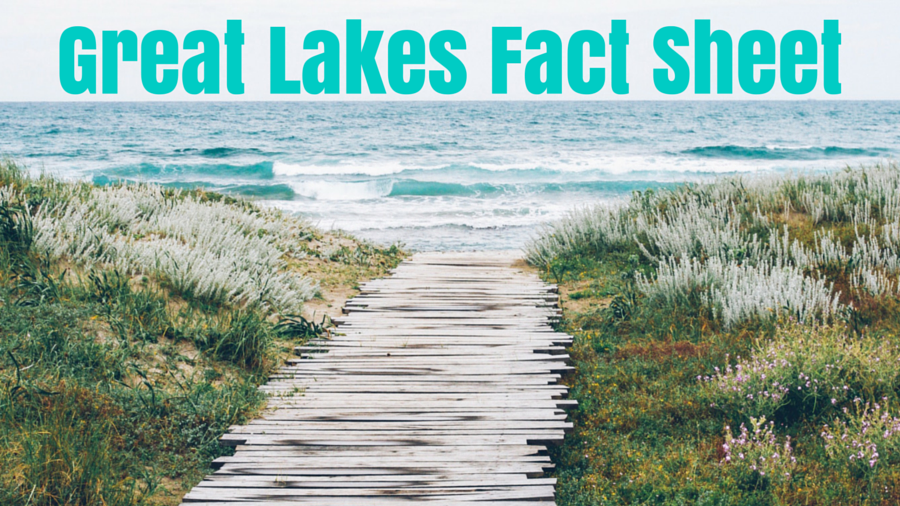Great Lakes Fact Sheet

The Great Lakes are one of the greatest riches of the United States. They spread across the border with Canada and throughout 8 states. They are made of 5 lakes, Ontario, Michigan, Erie, Huron and Superior. All together they represent the biggest formation of freshwater on Earth and their volume contains 21 percent of the world’s total surface fresh water. Lake Superior is the second largest lake in the world, while Michigan is the largest lake on the territory of one country. Lake Erie is the warmest and shallowest, while Lake Huron has the longest shoreline. The Great Lakes are the main transition, transportation, and trade routes in the area. They are also connected with the Atlantic Ocean by the St Lawrence River.
There are 35,000 islands in the Great Lakes and its water is a home to over 260 different species of fish. The water from the lakes are good for drinking too, supplying over 40 million people every day. For decades now the Great Lakes were the main economic engine to the Midwest region of the United States, bringing around 15 percent of American GDP. Almost 80 percent of the lake's shoreline is privately owned and not accessible to the public.
Lake Superior
Lake Superior is shared by the United States and Canada. It is considered the largest lake in the world by area and the third largest by volume. It spreads over 31,700 square miles with a maximum length of 350 statute miles and breadth of 160 statute miles. Its maximum depth is 1,333 feet, while the average depth is around 480 feet. The temperature of the lake varies over the seasons, but at a depth of 660 feet it is constantly around 39 degrees Fahrenheit. Winds, combined with the current, create waves during the entire year. Occasionally, thunderstorms can make waves up to 30 feet in height. Over 200 rivers feed Lake Superior. It drains into Lake Huron via St Mary’s River and Soo Locks, which were built to help ships overcome height difference of 25 feet between Superior and Huron.
Lake Michigan
Lake Michigan is the only one of the Great Lakes which is not shared with Canada. It is the third largest of the five lakes by the surface area and the second largest by volume. Some people consider Lake Michigan and Lake Huron one lake because the Straits of Mackinac connect the two lakes and gives the appearance of one, single water surface. Its 22,400 square miles puts it to the fifth position of largest lakes in the world with 307 miles length and 118 breadth. The average depth of the lake is 279 feet while the deepest bottom lays on 923 feet. Lake Michigan is well known for its clear water with an average temperature around 67 degrees Fahrenheit.
Lake Huron
Covering the area of 23,000 square miles, Lake Huron is the second largest of the Great Lakes. On the bigger picture, Huron is a third largest lake in the world both in surface area and volume. Length of the lake is 206 statute miles while its 183 statute miles breadth makes it widest of all Great Lakes. Maximum depth of the lakes is around 750 feet while the average depth is 195 feet. The average temperature of the water is around 54 degrees Fahrenheit, but during the summer it can go up to 75 degrees. Lake Huron is fed by the water from Lake Superior through the St Mary’s River, water then flows south through the St Clair River.
Lake Erie
The fourth largest out of the five Great lakes, Erie is also the shallowest and the smallest in volume. In terms of surface area, Erie takes thirteenth place in the world. Niagara River is its biggest natural outflow, providing a huge amount of hydroelectric power to both the United States and Canada. Over the decades, Lake Erie has experienced many environmental problems due to its size, with the main issues being pollution and overfishing. The lake covers the surface of 9,990 square miles with a maximum depth of 210 feet. Since Erie is the shallowest, its waters stay the warmest with an average temperature of 65 degrees Fahrenheit. Thanks to its low depth, Lake Erie is the first of the Great Lakes to freeze during the winter and is the easiest to be stirred by waves.

Check out ‘Creation of the Great Lakes’ from How the Earth Was Made (S1, E7) on YouTube
You are right
Cool
🤩
Wow
😯
Might want to proofread the surface area of Lake Ontario.
AN EASY way to remember the great lakes is homes, huron,ontario,michigan, Erie and superior
Hey, you will want to check your facts on this one. Lake Huron is not the third largest by volume or surface area in the WORLD, it is third among the great lakes in volume and second in surface area. Lake Ontario covers 7,340 square miles, not feet. Look it over.